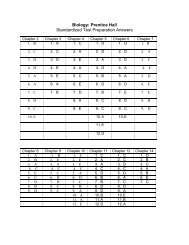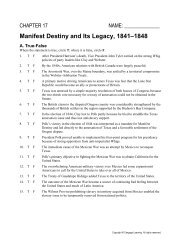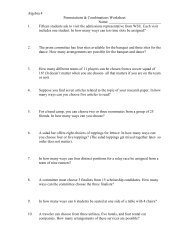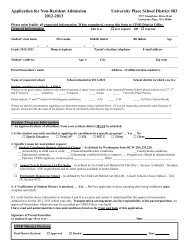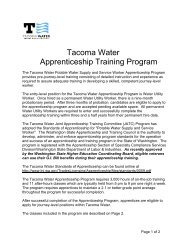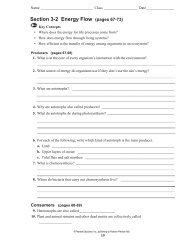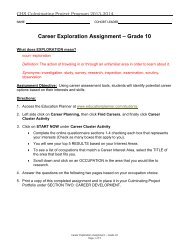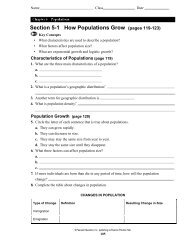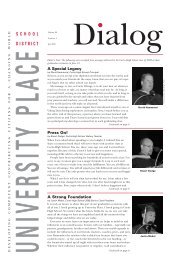Literature â Critical Theory & Critical Perspectives
Literature â Critical Theory & Critical Perspectives
Literature â Critical Theory & Critical Perspectives
Create successful ePaper yourself
Turn your PDF publications into a flip-book with our unique Google optimized e-Paper software.
<strong>Literature</strong> – <strong>Critical</strong> <strong>Theory</strong> & <strong>Critical</strong> <strong>Perspectives</strong><br />
What is literary or critical theory What is meant by “critical perspective”<br />
The terms ―literary theory‖ and ―critical theory‖ refer to essentially the same fields of study. They<br />
both address ways of looking at literature beyond the typical plot-theme-character- setting<br />
studies. Just as a PERSPECTIVE is a way of looking at something, a CRITICAL PERSPECTIVE is a<br />
way of criticizing or analyzing literature. Your CRITICAL PERSPECTIVE is the view you bring to the<br />
literature you read.<br />
How and why did literary theories develop<br />
We all know that different people will experience the same event differently. It follows, then,<br />
that different people will approach the same literary text differently. One person may be<br />
offended by a character’s actions, while another finds them comic. One reader is energized<br />
by a story’s political implications, while another is awed by the same story’s philosophical bent.<br />
Literary theories emerged as ways to explain different people’s views and responses to<br />
literature. Rather than insisting that one view is the best or correct view, literary theory attempts<br />
to find value in all views that are based on a careful study of the literature.<br />
What are the benefits of studying a work from more than one critical perspective<br />
There are several benefits:<br />
One of the views is likely to affirm your perspective and speak to what you see in the<br />
literature you are studying.<br />
Studying a view different from yours—not to disagree with it, but to understand it—helps<br />
you understand those who hold that view.<br />
Studying a work from more than one view gives you a deeper understanding of the<br />
author’s work and a better appreciation for the richness of it.<br />
What does studying a work from multiple critical perspectives involve<br />
Essentially, all you have to do to study a work from more than one critical perspective is to put<br />
your own view on hold and entertain the other view. Although you may be a staunch greenthinker,<br />
you now ask yourself, ―What would a yellow-thinker see in this work‖<br />
What does studying a work from multiple critical perspectives not involve<br />
First and foremost, studying a work from multiple critical perspectives does not require that you<br />
agree with any of the perspectives you study. You are not being asked to become a yellowthinker,<br />
only to consider—without criticism and judgment—what a yellow-thinker would see in<br />
the text. Second, studying a work from multiple critical perspectives does not require that you<br />
blend or merge two or more perspectives into a single interpretation. Some of the points of<br />
some of the theories are actually mutually exclusive and cannot be reconciled. While<br />
examining a work from the feminist perspective, you do not need to take into account what a<br />
Marxist would find. You would examine each perspective independently.<br />
What are the most common or popular critical theories<br />
This packet will introduce you to the following critical theories:<br />
Feminist<br />
Marxist<br />
Psychoanalytic or Freudian<br />
Archetypal or Mythological<br />
New Historicism
FEMINIST THEORY<br />
The basis of the feminist movements, both in literature and politics, is that Western culture is<br />
fundamentally patriarchal (i.e., created by men, controlled by men, viewed through the eyes<br />
of men, and evaluated by men). The 1960s saw the rise of a new, feminist approach to literary<br />
criticism. Before the emergence of Feminist <strong>Theory</strong>, the works of female writers (or works about<br />
females) were examined by the same standards as those by male writers (and about men).<br />
With the development of Feminist <strong>Theory</strong>, old texts are reexamined, and the portrayal of<br />
women in literature is reevaluated. New writers create works that more accurately reflect the<br />
developing concept of the ―modern woman.‖ The feminist approach is only partly based on<br />
finding and exposing suggestions of misogyny (negative attitudes toward women) in literature.<br />
Feminists are interested in exposing the ways women in literature—both authors and<br />
characters—are undervalued. Some feminist scholars have even dissected individual words in<br />
Western languages, suggesting that the languages themselves reflect a patriarchal worldview.<br />
Arguing that the past millennia in the West have been dominated by men— whether<br />
politicians in power or the historians recording it—feminist critics believe that Western literature<br />
reflects a masculine bias. As a result, Western literature presents an inaccurate and potentially<br />
harmful portrayal of women. In order to repair the potential harm done and achieve balance,<br />
feminist critics insist that works by and about women be added to the literary canon and read<br />
from a feminist perspective.<br />
Three main areas of study and points of criticism exist in the Feminist <strong>Theory</strong>:<br />
1. differences between men and women<br />
2. women in positions of power and power dynamics between men and women<br />
3. the female experience<br />
1. Differences between men and women<br />
• One basic assumption of the feminist perspective is that gender determines everything,<br />
including values and the ways language is used.<br />
• The canon of literature printed, marketed, and taught in schools must be expanded to<br />
include the study of genres in which women ―traditionally‖ write: journals, diaries, and<br />
personal letters.<br />
• The differences in the topics or issues about which men and women write and the<br />
differing viewpoints from which men and women write must be noted. All views must be<br />
respected as equally valid.<br />
2. Women in positions of power and power dynamics between men and women<br />
• Any evidence of the social, economic, and political exploitation of women must be<br />
noted and confronted. The feminist critic checks the work to see whether female<br />
characters have power and of what type of power it might be.<br />
• A feminist critic views literature as a means by which inequities can be identified,<br />
protested, and possibly rectified.<br />
• A feminist critic will note the division of labor and economics between men and women<br />
in the work being studied.<br />
• A feminist critic will note how male and female characters in the work interact with one<br />
another in a variety of contexts. Does the woman act subservient Does the man treat<br />
the woman like an adult Are males and females politically and economically equal<br />
3. The Female Experience<br />
• On the most basic levels, a woman’s experience of life is different from a man’s.<br />
Reading or viewing from a feminist perspective includes examining what aspects of<br />
feminine life are included in the work. Is the narrative point of view male or female<br />
• How does the narrator—male or female—treat plot events and other characters
Feminist <strong>Theory</strong> Continued<br />
• The feminist critic rejects any application of male standards to the female personality.<br />
The female personality must be judged independently from the male personality and<br />
vice versa.<br />
• Feminist critics examine and celebrate all portrayals of the creative, life-giving role of<br />
femininity. Women have traditionally been portrayed as dependent on men, but<br />
feminists point out that men are dependent on women for humanity’s most basic<br />
need—birthing children. All evidence of feminine nurture, healing, life giving and<br />
restoring are examined.<br />
• Feminist theory is not fundamentally chauvinistic. Feminist critics explore literature for<br />
portrayals of the concept that men and women are each incomplete without the<br />
other. They do, however, reject suggestions of studying only feminine ―incompleteness.‖<br />
Essential questions for a feminist reading:<br />
What stereotypes of women are depicted in the text<br />
Are female characters oversimplified Weak Foolish Excessively naive<br />
Do the female characters play major or minor roles in the action of the work<br />
Are they supportive or independent Powerless or strong Subservient or in control<br />
If the female characters have any power, what kind is it Political Economic Social<br />
Psychological<br />
Are the female characters and situations in which they are placed oversimplified or<br />
presented fully and in detail<br />
How do the male characters talk about the female characters<br />
How do the male characters treat the female characters<br />
How do the female characters act toward the male characters<br />
Are the female characters and situations in which they are placed oversimplified or<br />
presented fully and in detail<br />
How do the male characters talk about the female characters<br />
How do the male characters treat the female characters<br />
How do the female characters act toward the male characters<br />
How do the female characters act toward each other<br />
Is the work, in general, sympathetic to female characters Too sympathetic<br />
Do any of the work’s themes touch upon any idea that could be seen as a feminist<br />
issue Is the theme supportive or disparaging of women<br />
Overall, do you think that the female characters are believable For that matter, do<br />
you think that the male characters are believable<br />
Examining “Cinderella” from a Feminist Perspective<br />
Consider the potentially misogynist theme of abused-girl-waiting-to-be-rescued-byprince.<br />
Consider the values conveyed in the portrayal of the ―good girl‖ as physically beautiful<br />
and the ―wicked girls‖ as physically ugly.<br />
Examine the potentially misogynist theme of the courtship ritual of the prince’s ball:<br />
• By what standard (other than physical beauty) will he choose whom to marry<br />
• Will the chosen woman have a choice in whether or not to marry the prince<br />
• What is the basis of the prince’s ―love at first sight‖ with Cinderella<br />
Consider the feminist implication of<br />
• the fact that the ―good girl‖ is passive, weak, and submissive and can do nothing<br />
(and does do nothing) to improve her own condition;<br />
• the fact that the powerful woman is portrayed as wicked (and probably ugly).
MARXIST THEORY<br />
The Marxist approach to literature is based on the philosophy of Karl Marx, a German<br />
philosopher and economist. His major argument was that whoever controlled the means of<br />
production (the factories) in a society controlled the society. Marx noted a disparity in the<br />
economic and political power enjoyed by the factory owners and that allowed to the factory<br />
laborers. He believed that the means of production (i.e., the basis of power in society) should<br />
be placed in the hands those who actually operated them. He wrote that economic and<br />
political revolutions around the world would eventually place power in the hands of the<br />
masses, the laborers. To read a work from a Marxist perspective, one must understand that<br />
Marxism asserts that literature is a reflection of culture, and that culture can be influenced by<br />
literature. Marxists believe literature can instigate revolution.<br />
Four main areas of study:<br />
1. economic power<br />
2. materialism versus spirituality<br />
3. class conflict<br />
4. art, literature, and ideologies<br />
1. Economic Power<br />
• A society is shaped by its forces of production. Those who own the means of production<br />
dictate what type of society it is.<br />
• The two main classes of society are the bourgeoisie (who control the means of<br />
production and wealth) and the proletariat (who operate the means of production<br />
and are controlled by the bourgeoisie).<br />
• Since the bourgeoisie own the means of production—and, therefore, control the<br />
money— they can manipulate politics, government, education, art, and media.<br />
• Capitalism is flawed in that it creates commodification (a desire for possessions, not for<br />
their innate usefulness, but for their social value). Display of material objects is the most<br />
common way of showing off one’s wealth.<br />
• Commodification is one way the bourgeoisie keep the proletariat oppressed.<br />
Whenever the proletariat manages to acquire some sort of status symbol, the<br />
bourgeoisie concocts a new one; thus, the proletariat continues to struggle, never able<br />
to ―catch up.‖<br />
2. Materialism versus Spirituality<br />
• Regardless of what some might claim, social values reflect material goals, not abstract<br />
ideals.<br />
• The material world is the only non-subjective element in a society. Money and material<br />
possessions are the same by every measure within a society, whereas spirituality is<br />
completely subjective.<br />
• The quality of a person’s life is not destroyed by spiritual failure but by material failure.<br />
3. Class Conflict<br />
• A Capitalist society will inevitability experience conflict between its social classes.<br />
• The owners and the workers will have different ideas about the division of the wealth<br />
generated, and the owners will ultimately make the decision.<br />
• This constant conflict, or dialectical materialism, is what instigates change.<br />
• The bourgeoisie present their political, economic, and social structures as the only<br />
reasonable ones.<br />
• The proletariat, indoctrinated from birth to have pride in their station, are prevented<br />
from wanting to overthrow their oppressors (ironically, the smaller and actually lesspowerful<br />
group).
Marxist <strong>Theory</strong> Continued<br />
• The only real social division is class. Divisions of race, ethnicity, gender, and religion are<br />
artificial, devised by the bourgeoisie to distract the proletariat from realizing their unity<br />
and rebelling against their oppressors.<br />
• Marx called on the proletariat to reject the social structure of the bourgeoisie, the rules<br />
that would keep them subservient forever, and form their own values. Such a course<br />
would be the only way<br />
• to escape the oppression, for the proletariat could never defeat the bourgeoisie on its<br />
own terms. For the workers to win, they must establish new terms.<br />
4. Art, <strong>Literature</strong>, and Ideologies<br />
• Art and literature are among the vehicles by which the bourgeoisie impose their value<br />
system on the proletariat. The arts can make the current system seem attractive and<br />
logical, thus lulling the workers into an acceptance of it.<br />
• Works of art and literature are enjoyable, so the audience is unaware of being<br />
manipulated.<br />
• The bourgeoisie control most artistic output because, whether through patronage or<br />
sponsorship, they are the entity that funds the arts and entertainment. Since the<br />
bourgeoisie materially support the writers and the painters— owning the means of<br />
production as well as serving as primary consumers—the artist must be careful not to<br />
offend bourgeois values. Anything offensive or challenging to the bourgeoisie will simply<br />
not be published or sold.<br />
• Any artist who wishes to criticize the bourgeoisie must do so in a subtle way (satire, irony,<br />
etc.).<br />
Essential questions for a Marxist reading:<br />
• Who are the powerful people in the text Who are the powerless Who receives the<br />
most attention<br />
• Why do the powerful have the power Why are the powerless without power<br />
• Is there class conflict and struggle<br />
• Is there alienation and/or fragmentation evident in any of the characters If so, in<br />
whom The powerful The powerless<br />
• Do the powerful in the text suppress the powerless How News Media Religion<br />
<strong>Literature</strong><br />
• What can you infer from the setting about the distribution of wealth<br />
• What does the society value Are possessions acquired for their usefulness or their social<br />
value<br />
• Is the text itself a product of the society in which it was created How do you know<br />
• Is the work consistent in its ideologies, or is there an inner conflict<br />
• After reading this text, do you notice any system of oppression that you have<br />
accepted If so, what system, and how do you think you came to accept it<br />
Examining “Cinderella” from a Marxist Perspective<br />
Consider Cinderella as a representative of the proletariat:<br />
• oppressed by her bourgeoisie stepmother and stepsisters, who have stolen her rightful<br />
inheritance and turned her into a servant in her own home;<br />
• desiring to join the ranks of the bourgeoisie by marrying the prince.<br />
Consider the ball gown, glass slippers, and golden coach as evidence of commodification;<br />
without these possessions, Cinderella cannot hope to rise out of the proletariat and join the<br />
bourgeoisie.
PSYCHOANALYTIC OR FREUDIAN THEORY<br />
The Psychoanalytic or Freudian <strong>Theory</strong> encompasses two almost contradictory critical theories.<br />
The first focuses on the text itself, with no regard to outside influences; the second focuses on<br />
the author of the text. According to the first view, reading and interpretation are limited to the<br />
work itself. One will understand the work by examining conflicts, characters, dream<br />
sequences, and symbols. One will further understand that a character’s outward behavior<br />
might conflict with inner desires or might reflect as-yet-undiscovered inner desires.<br />
Main areas of study/points of criticism of the first view are:<br />
There are strong Oedipal connotations in Freudian theory:<br />
• the son’s desire for his mother<br />
• the father’s envy of the son and rivalry for the mother’s attention<br />
• the daughter’s desire for her father<br />
• the mother’s envy of the daughter and rivalry for the father’s attention.<br />
Of course, these all operate on a subconscious level to avoid violating serious social mores.<br />
There is an emphasis on the meaning of dreams.<br />
• It is in dreams that a person’s subconscious desires are revealed.<br />
• What a person cannot express or do because of social rules will be expressed and<br />
accomplished in dreams, where there are no social rules.<br />
• Most of the time, people are not even aware what they secretly desire until their<br />
subconscious goes unchecked in sleep.<br />
According to psychoanalytic theory, there are three parts to the subconscious, which is the<br />
largest part of the human personality:<br />
1. The id—the basic desire.<br />
The id has no sense of conscience, thus making it everyone’s ―inner child.‖ Children,<br />
before they are taught social skills, operate entirely through the id. They cry in public,<br />
perform bodily functions with no sense of shame, and demand immediate<br />
gratification of their needs and desires.<br />
2. The superego—the opposite of the id.<br />
• The superego is the repository of all socially imposed behavior and sense of guilt.<br />
While the id is innate, the superego is learned. Humans develop a superego by<br />
having parents scold them and other members of society teach them.<br />
• How one is socialized—by punishment and shame—will have a lifelong impact on<br />
the functioning of his or her subconscious.<br />
3. The ego—reality.<br />
• The ego struggles to achieve a balance between the id and the superego. The ego<br />
takes the desires of the id, filters them through the superego, and devises an action<br />
that satisfies both. The ego realizes that the id must be satisfied but that there are<br />
certain socially acceptable ways to achieve satisfaction.<br />
• Freudian theory asserts that psychological problems are all the result of imbalances<br />
between the id, superego, and ego.<br />
Main areas of study/points of criticism of the second view:<br />
An essential relationship exists between the author of the work and the work itself. In<br />
order to understand a work, one must fully understand the author’s life and values.<br />
Although a work might not be blatantly autobiographical, psychoanalysts argue that<br />
there is always something of the author in the work, whether it be a character,<br />
character trait, theme, or motif.<br />
Often, authors will satirize characters they dislike or will be overtly sympathetic to those<br />
they do like.
Psychoanalytic/Freudian <strong>Theory</strong> Continued<br />
This author’s bias often has an effect on the reader, which is exactly what the author<br />
wants. When reading, people are extremely vulnerable to the author’s chosen point of<br />
view (the only way they hear the story is through the author’s narrator).<br />
This type of psychoanalytic reading includes the following:<br />
• Reference to what is known or surmised about the author’s personality is used to explain<br />
and interpret a literary work. For example, Charles Dickens grew up poor and later<br />
wrote books sympathetic to boys growing up poor.<br />
• Reference to a literary work is made in order to establish an understanding of the mind<br />
of the author. For example, judging by Harper Lee’s To Kill a Mockingbird, one might<br />
reasonably conclude that Harper Lee herself was sympathetic to the plight of black<br />
Americans.<br />
• Studying the literary work of an author is a means of knowing the author as a person.<br />
The more novels by Charles Dickens one reads, the more one can infer about the<br />
author’s beliefs, values, hopes, fears, etc.<br />
• An artist may put his or her repressed desires on the page in the form of actions<br />
performed by characters. For example, an author who consistently writes stories in<br />
which his female characters are weak, dependent, or unintelligent might be expressing<br />
latent misogynist tendencies. Likewise, a female author might express her latent<br />
misandry through weak, blatantly evil, or thoroughly inconsequential male characters.<br />
Essential questions for a psychoanalytic reading are:<br />
• What are the traits of the main character<br />
• How does the author reveal those traits<br />
• What do you learn about the character through the narrator<br />
• What do you learn about the character from the way other characters relate to him or<br />
her<br />
• What do you infer about the character from his or her thoughts, actions, and speech<br />
• What discrepancies exist between the author’s portrayal of the character and how<br />
other characters react to him or her<br />
• What discrepancies exist between the author’s portrayal of the character and the<br />
reader’s inferences<br />
• Is the main character a dynamic character (does he or she change throughout the<br />
course of the story) If so, how and why<br />
• How does the character view him or herself<br />
• What discrepancies exist between a character’s view of him or herself and other<br />
characters’ reactions, the author’s portrayal, and/or reader inference<br />
• How do the characters view one another<br />
• Is there any discrepancy between a character’s personal opinion of him or herself and<br />
how others think about him or her<br />
• What types of relationships exist in the work<br />
• What types of images are used in conjunction with the character What do they<br />
symbolize<br />
• What symbols are used in the course of the story What do they symbolize<br />
• Do any characters have dreams or inner monologues What is revealed about a<br />
character through dreams that would not otherwise be revealed<br />
• Are there any inner conflicts within the character How are these conflicts revealed<br />
How are they dealt with Are they ever resolved How<br />
• Do any characters perform uncharacteristic actions If so, what What could these<br />
actions mean
Psychoanalytic/Freudian <strong>Theory</strong> Continued<br />
Examining “Cinderella” from a Psychoanalytic Perspective<br />
• Consider Cinderella as a representative of the id —expressing desire.<br />
• Consider the stepmother and stepsisters as representatives of the superego—preventing<br />
the id from fulfilling its desire.<br />
• Consider the fairy godmother and the prince as representatives of the ego—<br />
negotiating between the id and the superego and allowing the desires of the id to be<br />
fulfilled in a socially acceptable manner.<br />
• Examine the discrepancy between the narrator’s depiction of the stepmother and<br />
stepsisters and their views of themselves.<br />
• Examine the text for evidence of latent misogyny or misandry on the part of Charles<br />
Perrault (or the Grimm brothers).
ARCHETYPAL OR MYTHOLOGICAL THEORY<br />
Mythological, archetypal, and psychological criticism are all closely related. This is because<br />
Freud based many of his theories on the idea of the social archetype. His pupil, Carl Jung,<br />
refined Freud’s theories and expanded them into a more cross-cultural philosophy. Critics who<br />
examine texts from a mythological/archetypal standpoint are looking for symbols. Jung<br />
defined an archetype as ―a figure...that repeats itself in the course of history wherever<br />
creative fantasy is fully manifested.‖ Jung theorized that human beings were born with an<br />
innate knowledge of certain archetypes. The evidence of this, Jung claimed, lay in the fact<br />
that some myths are repeated throughout history in cultures and eras that could not possibly<br />
have had any contact with one another. Every culture has a creation story, a-life-after-death<br />
belief, and a reason for human failings, and these stories— when studied comparatively—are<br />
far more similar than different. When looking for archetypes, critics take note of general<br />
themes, characters, and situations that recur in literature across writers, genres, periods, and<br />
societies. Traditional literary and mythological archetypes can be successfully translated to<br />
other genres and time periods. Because they draw on feelings, situations, concerns, and issues<br />
that have been a part of the human condition in every generation, the plays of William<br />
Shakespeare, the novels of Jane Austen, the episodes of Homer can be, and have been,<br />
updated and reformatted time and time again.<br />
Three main points of study:<br />
1. archetypal characters<br />
2. archetypal images<br />
3. archetypal situations<br />
1. Archetypal Characters<br />
the HERO<br />
• a figure, often larger than life, whose search for identity and/or fulfillment results in his or<br />
her destruction (often accompanied by the destruction of society in general).<br />
• The aftermath of the death of the hero, however, results in progress toward some ideal.<br />
• While this applies to modern superheroes such as Superman (Clark Kent, searching for<br />
the balance between his super self and his mortal identity), it also applies to the central<br />
figures in many religions.<br />
• Christianity’s Jesus, who must come to terms with his destiny as the Messiah, Judaism’s<br />
Moses, reluctant to fulfill his assigned destiny as the leader of the Israelites, and<br />
thousands of other literary and religious figures throughout history are examples of the<br />
archetype.<br />
Variations of the HERO figure include<br />
• the ―orphaned‖ prince<br />
• the lost chieftain’s son<br />
• either raised ignorant of his heritage until he is rediscovered (King Arthur, Theseus).<br />
the SCAPEGOAT:<br />
• an innocent character on whom a situation is blamed—or who assumes the blame for<br />
a situation—and is punished in place of the truly guilty party, thus removing the guilt<br />
from the culprit and from society.
Archetypal/Mythological <strong>Theory</strong> Continued<br />
the LONER or OUTCAST:<br />
• a character who is separated from (or separates him or herself from) society due to<br />
either an impairment or an advantage that sets this character apart from others. Often,<br />
the Hero is an outcast at some point in his or her story.<br />
• Jesus goes into the desert to discern his destiny.<br />
• Buddha leaves society to attain Nirvana.<br />
• Victor Frankenstein travels to remote locales to avoid people when he realizes that he<br />
has created a monster.<br />
Two common variations of the LONER are<br />
• the UNDERDOG, the smaller, weaker, lessworldly wise character, who usually<br />
emerges victorious at the end of the story;<br />
• the guilt-ridden figure in search of redemption.<br />
the VILLAIN:<br />
• the male or female personification of evil.<br />
• While nearly all works of literature include an antagonist to provide conflict with the<br />
protagonist, not all antagonists are villains.<br />
• Villains personify evil. Their malice is often apparently unmotivated, or is motivated by a<br />
single grievance from the past. The villain’s malice is often limitless, and rarely is the<br />
villain reformed within the context of the story. Examples of archetypal villains are Satan<br />
and Loki, from Norse mythology.<br />
Some variations of the VILLAIN figure include:<br />
• the ―mad scientist‖<br />
• the bully<br />
the TEMPTRESS:<br />
• the female who possesses what the male desires and uses his desire (either intentionally<br />
or unintentionally) as a means to his ultimate destruction. Examples are Eve, Juliet, Lady<br />
Macbeth.<br />
the EARTH MOTHER/GODDESS:<br />
• Mother Nature, Mother Earth—the nurturing, life-giving aspect of femininity.<br />
the SPIRIT or INTELLECT:<br />
• the often-unidentified feminine inspiration for works of art and literature. Examples<br />
would be Dante’s Beatrice, Shakespeare’s Dark Lady, etc.<br />
the SAGE:<br />
• largely of Eastern origin, the sage is the elderly wise man, the teacher or mentor.<br />
Examples from Western literature would be Merlin and Tiresias.<br />
• Yoda from Star Wars and Gandalf from The Hobbit and The Lord of the Rings are<br />
contemporary derivations.<br />
Some variations of the SAGE include:<br />
• the wise woman, the crone, or witch. Note that, while the male SAGE’s wisdom is<br />
usually spiritual or philosophical (often with political or military applications), the wise<br />
woman’s wisdom tends to concern the workings of nature—hence, the connection<br />
of the wise woman with witchcraft and the associated superstitions.<br />
• the stern, but loving authority figure.<br />
• the oracle: male or female prophet, fortuneteller, soothsayer.
2. Archetypal Images<br />
COLORS:<br />
• red as blood, anger, passion, violence;<br />
• gold as greatness, value, wealth;<br />
• green as fertility, luxury, growth;<br />
• blue (the color of the sky) as peace, serenity;<br />
• white as purity, goodness, God-like holiness, etc.<br />
Archetypal/Mythological <strong>Theory</strong> Continued<br />
NUMBERS:<br />
• three for the Christian Trinity, stability (a stand with three legs can stand steadily on<br />
• most surfaces);<br />
• four for the four seasons, the four ancient elements (earth, water, fire, air);<br />
• twelve for the months of the year, the tribes of ancient Israel, the apostles of Jesus.<br />
WATER:<br />
• the source of life and sustenance; cleansing or purification; baptism.<br />
FIRE:<br />
• ambiguously both protective and destructive;<br />
• on an archetypal level, fire often symbolizes human knowledge and industry<br />
(Prometheus stole fire from the gods and gave it to humankind when there were no<br />
other gifts left to give.)<br />
The FOUR ANCIENT ELEMENTS:<br />
• fire<br />
• water<br />
• air<br />
• earth<br />
GARDENS:<br />
• natural abundance;<br />
• easy, beautiful life;<br />
• new birth, hope;<br />
• Eden, the original Paradise from which humankind was expelled.<br />
GEOMETRIC SHAPES:<br />
• a triangle for the Trinity<br />
• a circle for perfection and eternity, wholeness, union.<br />
CELESTIAL BODIES:<br />
• the sun (masculine) is both the giver and destroyer of life<br />
• the moon (feminine) marks the passage of time and controls the course of human<br />
events. Planting, harvesting, etc., are all determined more by the phases of the moon<br />
than the progress of the sun.<br />
MASCULINE IMAGES/SYMBOLS:<br />
• columns<br />
• towers<br />
• boats<br />
• trees<br />
• etc.
FEMININE IMAGES/SYMBOLS:<br />
• bodies of water<br />
• caves<br />
• doorways<br />
• windows.<br />
Archetypal/Mythological <strong>Theory</strong> Continued<br />
CAVES:<br />
• ambiguously can represent the womb (the source of life) and the grave<br />
• often represent the entrance to the underworld (related to the grave), as well as to the<br />
unexplored regions of the human mind and soul.<br />
YIN AND YANG:<br />
• any scheme that suggests that each of a pair of opposites partakes of the other’s<br />
nature, complements the other, and essentially completes the other; the idea that<br />
without a balance of opposing forces, the world would erupt into chaos.<br />
3. Archetypal Situations<br />
the QUEST:<br />
• the hero’s endeavor to establish his or her identity or fulfill his or her destiny.<br />
Variations on the QUEST can include:<br />
• the Faustian bargain: the selling of one’s soul to the devil (metaphorically<br />
representing the notion that one would ―give anything‖ in order to…) in exchange<br />
for unlimited power, knowledge, wealth, etc. Examples include King Midas.<br />
• the pursuit of revenge for a real or perceived wrong, as exemplified by Captain<br />
Ahab’s quest in Moby Dick.<br />
• the descent into the underworld. (Note that this is usually one part of the quest<br />
rather than the entire quest itself.)<br />
Steps (or stages) into which the QUEST can be divided:<br />
The CALL:<br />
Typically, the Hero is challenged to embark on the Quest or is called to it by a<br />
god or god-figure. Usually there is a sense of destiny associated with the call to<br />
the quest – this is the Hero’s purpose; it will be his or her defining moment.<br />
The DECISION:<br />
The Hero makes an intentional decision to accept the challenge or call and<br />
pursue his (or her) destiny. There is usually a sense that this decision is irrevocable<br />
– the ship sails, the bridge burns, the home planet is destroyed, etc. At this point,<br />
the Hero must go forward; there is no turning back.<br />
The PREPARATION:<br />
This is the period during which the Hero learns what he or she needs to know in<br />
order to complete the Quest. He or she develops the skills, builds the strength,<br />
gathers the tools and other materials, and collects the allies he or she will need<br />
to succeed. Often the Hero will meet a MENTOR, an older, wiser individual who<br />
has the knowledge and skills the Hero needs. This MENTOR may or may not<br />
supernatural.
Archetypal/Mythological <strong>Theory</strong> Continued<br />
Steps (or stages) into which the QUEST (continued):<br />
The OBSTACLES:<br />
This is the quest itself, the journey to the palace where the treasure is hidden or<br />
the captive is imprisoned. It is a long trip. I tis a dangerous trip. Many of the Hero’s<br />
allies will desert him or her, be rendered incapable of continuing, or die. The Hero<br />
will lose many if not all, of the tools and weapons collected during the<br />
Preparation and will have to continue the Quest alone.<br />
Some of the Obstacles encountered might be in the form of persons:<br />
The TEMPTOR/TEMPTRESS or SEDUCER/SEDUCTRESS, who is able to offer the<br />
Hero something he or she deeply desires (often a hidden or secret desire) so<br />
that the Hero is (almost) willing to abandon the quest.<br />
The SHADOW, an evil figure who actually mirrors those things the Hero most<br />
fears or dislikes about himself/herself<br />
Some of the Obstacles encountered might be geographical:<br />
Difficult terrain<br />
Remote locations<br />
Seemingly insurmountable mountains, oceans, rivers, etc.<br />
Some of the Obstacles encountered might take the particular forms:<br />
mythical animals and beings<br />
legendary animals and beings<br />
The CLIMAX:<br />
This is, of course, the moment when the Hero is at the point of either succeeding<br />
or failing. The failure might be physical, emotional, or psychological. The climax<br />
also involves the movement when it becomes obvious that the Hero will<br />
succeed.<br />
The RETURN:<br />
After the successful Quest, the Hero returns home, but he or she always returns a<br />
changed person.<br />
the RENEWAL OF LIFE:<br />
• death and rebirth, resurrection as seen in the cycle of the seasons, the phases of the<br />
day, sleeping and waking. Examples are ―Sleeping Beauty,‖ ―The Secret Garden,‖ etc.<br />
INITIATION:<br />
• coming of age, rites of passage. Some examples include the first hunt, weddings,<br />
teenage angst films.<br />
THE FALL:<br />
• any event that marks a loss of innocence; a devolution from a paradisiacal life or<br />
viewpoint to a painted one.<br />
REDEMPTIVE SACRIFICE:<br />
• any voluntary loss, especially a loss of life, that results in another’s gaining or regaining a<br />
desired state.<br />
the CATALOG OF DIFFICULT TASKS:<br />
• (labors of Hercules, Cinderella’s treatment by her stepmother and stepsisters, etc.).
Archetypal/Mythological <strong>Theory</strong> Continued<br />
the END OF THE WORLD:<br />
• usually apocalyptic, involving warfare, a huge battle, a metaphoric final battle<br />
between good and evil.<br />
Variations on the end of the world include<br />
• Armageddon: the final battle between good and evil according to the Christian<br />
New Testament (book of Revelation), in which evil is finally vanquished, evildoers<br />
receive their eternal punishment, and God reigns over a newly created Heaven<br />
and Earth;<br />
• Ragnarok: the final battle between two feuding segments of the Norse pantheon.<br />
Both sides are largely decimated, as is the human race. Two humans survive to<br />
repopulate the human world and worship a new pantheon formed of the gods who<br />
survive the battle.<br />
• the Great Flood: found in the Judeo-Christian worldview and other belief systems<br />
from around the world, the story of a great deluge that covered the earth with<br />
water, killing an entire generation of life<br />
• forms on earth. A handful survived, repopulating the earth. According to these<br />
several accounts, the flood was a punishment for human wrongdoing.<br />
the TABOO:<br />
• the commission of a culturally forbidden act, such as incest or patricide, often<br />
unknowingly or inevitably. Any act or attitude that can be seen as ―unnatural,‖ a crime<br />
against the ways Nature is supposed to operate.<br />
the BANQUET:<br />
• fellowship; nourishment of the body and soul; display of wealth; often used as a symbol<br />
for salvation, Heaven.<br />
Essential questions for a mythological/archetypal reading:<br />
• Examine all of the characters—major and minor—and their situations. What archetypes<br />
seem to be present<br />
• How do any of the characters change over time What events or people make them<br />
change<br />
• What is suggested in the setting (time of day, season of year, location—garden, body<br />
of water, etc.) that might suggest an archetypal reading<br />
• What types of symbols are used What do they represent<br />
• How are the symbols in this work different from the traditional uses of those symbols<br />
What is significant about this difference<br />
• What myths are at work in different parts of this work What features of the story are<br />
reminiscent of other stories you know<br />
Examining “Cinderella” from an Archetypal Perspective<br />
• Consider Cinderella’s attendance at the ball as symbolic of her attaining salvation. (The<br />
tasks assigned to her by her stepmother and stepsisters—the tempters—distract her from<br />
focusing on her own salvation. Through the agency of a supernatural entity—the fairy<br />
godmother—she receives the unearned love of the prince.)<br />
• Examine the stepmother and stepsisters as archetypal villains.<br />
• Examine the chores Cinderella must complete (especially involving the beans in the<br />
fireplace in Grimm version) as the archetypal catalogue of difficult tasks.
NEW HISTORICISM<br />
A common tendency in the study of literature written in, and/or set in, a past or foreign culture<br />
is to assume a direct comparison between the culture as presented in the text and as it really<br />
was. New Historicism asserts that such a comparison is impossible for two essential reasons.<br />
First, the “truth” of a foreign or past culture can never be known as established and<br />
unchangeable.<br />
• Any understanding of the ―truth‖ is, at best, a matter of interpretation on the parts of<br />
both the writer and the reader.<br />
• This is most blatantly evident in the fact that the ―losers‖ of history are hardly ever heard.<br />
The culture that is dominated by another is often lost to history because it is the<br />
powerful who have the resources to record history.<br />
• Even in recent past events, who really knows both sides of the story Who really knows<br />
the whole of the Arab-Israeli story Or the Iraqi story<br />
• New Historicists argue that these unknown histories are just as significant as the histories<br />
of the culture of power and should be included in any world-view.<br />
• Since these unrepresented or underrepresented histories often contradict ―traditional‖<br />
understandings, there is no way to know the absolute historical truth.<br />
Second, while the text under consideration does indeed reflect the culture in which it was<br />
written (and to some degree in which it is set), it also participates in the culture in which it is<br />
written.<br />
• The very existence of that text in its culture changes the culture it ―reflects.‖<br />
• While works like To Kill a Mockingbird and A Raisin in the Sun certainly reflected the<br />
culture of the mid-20th century United States, both also raised awareness of prejudice<br />
and injustice and helped to bring about change.<br />
Main areas of study/points of criticism:<br />
Traditional history is, by its nature, a subjective narrative, usually told from the point of view of<br />
the powerful.<br />
• The losers of history do not have the means to write their stories, nor is there usually an<br />
audience interested in hearing them. Most cultures, once dominated by another, are<br />
forced to forget their past.<br />
• To maintain its sovereignty, the culture of power simply does not allow the defeated<br />
culture to be remembered.<br />
• Traditional history is not only subjectively written, it is also read and discussed<br />
subjectively.<br />
• Although modern readers say they take history at face value, no one can help but<br />
compare the past to the present as a means of understanding it, which makes it<br />
subjective.<br />
The powerless also have ―historical stories‖ to relate that are not to be found in official<br />
documents, mostly because they played no hand in creating those documents. No reader<br />
can claim to have the ―truth‖ of a text or event; or even that an understanding of the ―truth‖ is<br />
possible. At best, one can acknowledge the validity of a particular point of view.<br />
When examining a text, the questions to ask are not:<br />
• Are the characters based on real people<br />
• Are any characters or events in the text drawn from the author’s life and experiences<br />
• Is the text an accurate portrayal of the time period in which it is set<br />
Instead, ask:<br />
• What view or understanding of the relevant culture does this text offer<br />
• How does this text contribute to or shape an understanding of the culture it represents
New Historicism <strong>Theory</strong> Continued<br />
The text, rather than being a static artifact of a definable culture, is a participant in a<br />
dynamic, changeable culture. Every reader brings to the text a unique set of experiences and<br />
points of view that alter the meaning of the text.<br />
Essential questions for a New Historicist reading:<br />
• What events occurred in the writer’s life that made the author who he or she is What<br />
has affected his or her view of life<br />
• Who influenced the writer What people in his or her life may have helped form this<br />
world-view<br />
• What did the writer read that affected his or her philosophy<br />
• What were the writer’s political views Was he or she liberal Conservative Moderate<br />
• In what level in the social order was the writer raised How did his economic and social<br />
situation affect him or her<br />
• To what level in the social order did the writer aspire<br />
• From what level in the social order did the writer’s friends come How were they<br />
employed<br />
• How powerful or influential was the writer socially<br />
• What were the writer’s social concerns What did he or she do about them<br />
• What type of person was the writer in his or her society<br />
• What was happening in the world at the time the book was written What was<br />
occurring during the time in which it is set<br />
• What were some major controversies at the time the book was written The time in<br />
which it is set<br />
• Who was on either side of the controversy Who were the powerful Who were the<br />
powerless<br />
• Why were the powerful in their positions of power What qualities did they have What<br />
events transpired to get them to their positions<br />
• What is similar about the perspective of this book and other books written in or about<br />
the same era<br />
• What is different<br />
• How did the public receive the work when it was first published What factors helped<br />
shape this reception<br />
• How did the critics receive the work when it was first published What factors helped<br />
shape this reception<br />
• Did this work have any impact on its society or culture What was the nature of this<br />
impact<br />
• What different or untraditional perspectives of history does this text represent<br />
• How does this text adhere to the conventions of literature in the era in which it was<br />
written<br />
• How does this text violate or depart from those conventions<br />
Examining “Cinderella” from a New Historicist Perspective<br />
• What can we infer about the society in which this story—considering, especially, the<br />
violence and vengeance in the Grimm version—would evolve and be told to young<br />
children<br />
• What can we infer about property and inheritance laws in the society in which<br />
―Cinderella‖ evolved What can we infer about the society’s view of royalty and<br />
monarchic power<br />
• What societal and cultural values can we infer about<br />
• family relationships<br />
● rewards for ―goodness‖<br />
• the nature of ―goodness‖<br />
● the status of women



